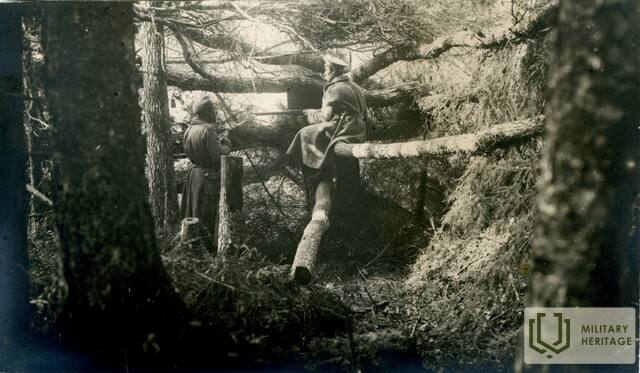Šmardeno mūšis I WW1

Po nesėkmingo liepos mėnesio puolimo netoli Kekavos Rusijos 12-osios armijos vadovybė nedelsdama pradėjo ruošti kovinę operaciją Kuršo invazijai. Smūgis turėjo vykti dviem kryptimis – netoli Ruojos iš 12 transporto laivų būtų paleistos pėstininkų ir kavalerijos desantinės pajėgos, kurias saugotų Baltijos laivyno laivai. Tada šie kariai nedelsdami turėtų pasukti į Tukumą, o tuo pačiu metu netoli Smārdės būtų pradėtas frontalus puolimas prieš vokiečių gynybines pozicijas. Skirtingai nuo Mirties salos ir pozicijų Kekavos-Olainės rajone, netoli Smārdės abu priešininkus skyrė plati „neutrali zona“ – kelių kilometrų pločio teritorija, kurios neužėmė nė viena pusė. Jai įveikti ir priešo pozicijoms užimti Rusijos vadovybė skyrė nemažas pajėgas – 37 pėstininkų batalionus ir 138 pabūklus, taip pat šarvuotą traukinį.
Iš šių pajėgų penki buvo Latvijos šaulių batalionai (2-asis, 4-asis, 5-asis, 7-asis, 8-asis batalionai), kurie pirmą kartą buvo sujungti į pulkininko Andrejaus Auzano vadovaujamą brigadą taktinei užduočiai atlikti. Vasarą į Latvijos batalionus buvo įtrauktos dar dvi kuopos ir dvi komandos – granatsvaidžių ir bombonešių. Dėl to batalionų skaitinė sudėtis gerokai padidėjo ir jie jau artėjo prie vokiečių pėstininkų pulkų skaičiumi. Latvijos šauliai ankstesniuose mūšiuose įgijo vertingos kovinės patirties ir pelnė vadovybės pripažinimą. Iš viso Smārdės puolimo operacijai buvo priskirti 32 pėstininkų batalionai, penki Latvijos šaulių batalionai, 144 pabūklai ir šarvuotas traukinys. Jei frontas būtų pralaužtas, iš rezervo būtų žygiavę penki kavalerijos pulkai su keliais šarvuočiais. Čia vokiečių armijos pozicijose buvo sustiprinti 29-osios Landesvero brigados daliniai su stipria artilerijos grupe. Engurės ežere buvo dislokuotas vokiečių hidroplanų dalinys, o Rygos įlanką kontroliavo Rusijos karinis jūrų laivynas. Pačiame Kurše ilgą jūros pakrantę gynė nedidelės vokiečių pajėgos – daugiausia kavalerijos ir Landsturmų, arba žemės sargybos, kuopos.
Pirmasis Smārdės operacijos etapas miškingoje ir pelkėtoje vietovėje prasidėjo rugpjūčio 5 d., kai Latvijos šaulių batalionai pradėjo žvalgybą Smārdės smuklės rajone. Latvijos batalionai palaipsniui pradėjo veržtis į „neutralią“ zoną tarp vokiečių ir rusų pozicijų, statydami įtvirtinimus ir tiekimo kelius, kad paruoštų placdarmą artėjančiai pagrindinei atakai. Pelkėtoje vietovėje tai buvo labai sunku padaryti. Didžiausias tiekimo kelias, kurį šauliai sunkiai dirbo, buvo vadinamas „Latvijos keliu“. Latvijos šauliai kartu su rusų daliniais įveikė aršų vokiečių pasipriešinimą ir iki rugpjūčio 30 d. užėmė didžiąją dalį neutralios zonos. Taigi, pirmasis Rusijos vadovybės suplanuotos operacijos etapas buvo baigtas. Tačiau tęsinys nebuvo tęsiamas – armijos vadovybė nusprendė atšaukti tiek rizikingą desanto operaciją, tiek sausumos ataką Tukumo kryptimi. Latvijos šaulių nuostoliai per kelias savaites trukusias kovas Smārdės pelkėse ir miškuose (žuvo apie 50 kareivių, daugiau nei 250 karininkų, puskarininkių ir šaulių buvo išmušti iš rikiuotės, jie buvo išsiųsti gydytis į ligonines) pasirodė esą bergždži. Smārdės mūšiuose dalyvavo ir Aleksandras Grīns, kuris nuo rugpjūčio 20 d. kovojo 4-ojo Vidžemės latvių šaulių pulko 1-osios kuopos sudėtyje.
Daugiau informacijos šaltinių
http://latviesustrelniekusaraksts.lv/Kaujas_darbiba/Book_5.html
https://www.dveseluputenis.lv/lv/laika-skala/notikums/83/sakas-smardes-kaujas/
Susijusi laiko juosta
Susijusios vietos
Paminklas suomių jėgerių-saperių atminimui
Įsikūręs Engurės savivaldybėje, A10 greitkelio pakraštyje, netoli Smārdės smuklės.
Memorialas yra lauke priešais Smårde barą, kur 1916 m., Pirmojo pasaulinio karo metu, įvyko Smårde mūšis. Kovose Vokietijos armijos sudėtyje dalyvavo suomių jėgerių inžinerinė kuopa (apie 200 vyrų). „Smårde diena“ tapo oficialia Suomijos armijos karo inžinierių švente, kuri švenčiama ir šiandien.
Suomijos jėgeriai buvo Vokietijos armijos dalinys, suformuotas Pirmojo pasaulinio karo metu. Juos daugiausia sudarė nacionalistiškai nusiteikę suomių savanoriai iš Rusijos imperijos ir Suomijos. Smårde mūšis buvo vienas reikšmingiausių suomių jėgerių puolimo mūšių, kuriame tuo metu buvo naudojama nauja taktika.
Praėjus mėnesiui po šio įvykio, Rusijos armija puolė vokiečių armiją netoli Smārdės. Latvijos koviniai daliniai atliko Smārdės apylinkių žvalgybą, nutiesė tiekimo kelią „Latvijos kelią“ per pelkę ir dalyvavo kovose. Mūšiuose žuvo apie 300 latvių kovotojų. Kaip ir suomių jėgeriai vokiečių armijoje, latvių šauliai Rusijos armijoje buvo savo nacionalinių valstybių ir armijų kūrėjai.





